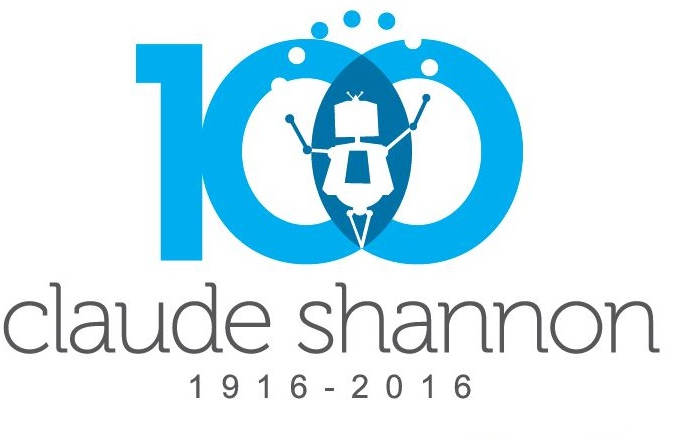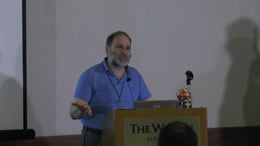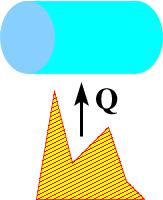- Abstracts, Lecture Materials, and Video
- The talk, streaming from Ohio State University: Streaming Video: Real Media (requires a RealPlayer) (may be dead link)
- The talk, copy on this website:
mbi-schneider-2005nov17.mov
(can play in a browser)
Posted with permission from MBI. -
Title: Molecular Information Theory: From Clinical Applications To Binding Site Evolution
Author: Thomas D. Schneider
Abstract:
Information theory was introduced by Claude Shannon in 1948 to precisely characterize data flows in communications systems. The same mathematics can also be fruitfully applied to molecular biology problems. We start with the problem of understanding how proteins interact with DNA at specific sequences called binding sites. Information theory allows us to make an average picture of the binding sites and this can be shown with a computer graphic called a sequence logo (https://alum.mit.edu/www/toms/glossary.html#sequence_logo).
Sequence logos show how strongly parts of a binding site are conserved in bits of information. They have been used to study a variety of genetic control systems. More recently the same mathematics has been used to look at individual binding sites using another computer graphic called a sequence walker (https://alum.mit.edu/www/toms/glossary.html#sequence_walker). Sequence walkers are being used to predict whether changes in human genes cause mutations or are neutral polymorphisms. It may be possible to predict the degree of colon cancer by this method.
How do genetic systems gain information by evolutionary processes? Information theory was used to observe information gain in the binding sites for an artificial `protein' in a computer model of evolution. The model begins with zero information and, as in naturally occurring genetic systems, the information measured in the fully evolved binding sites is close to that needed to locate the sites in the genome. The transition is rapid, demonstrating that information gain can occur by punctuated equilibrium. (https://alum.mit.edu/www/toms/paper/ev).
- related paper: https://alum.mit.edu/www/toms/paper/ev.
Why is the Genetic Code Degenerate? by Tom Schneider at Bits <-> Biology 2014 May 1, Building E14, 6th floor, MIT, Cambridge, Massachusetts
- Abstract: Why is the Genetic Code Degenerate?
- Video from the Wayback Machine (Note: the original MIT TechTv video link was broken and the video was lost. On 2021 Nov 04, Jonathan Bartlett discovered it on the Wayback machine! Many thanks to him!)
- Video from this website
- PDF of slides (from original cba.mit.edu website)
PDF of slides (from this website)
Three Principles of Biological States: Ecology and Cancer by Tom Schneider 2014 Oct 29 Wednesday 09:04-10:13 at the meeting Biological and Bio-Inspired Information Theory (14w5170) at the Banff International Research Station (BIRS), Banff, Canada.
-
Abstract:
I discuss genetic control systems and rhodopsin and the information theory which explains why their isothermal efficiency is often near 69%. This result is explained by understanding the high dimensional coding space that molecular machines function in. Surprisingly, the same theory applies to ecological and developmental systems and leads to a global understanding of cancer incidence in the body. I even can analyze data from the Cambrian Burgess Shale that represents an ecosystem half a billion years ago! Three fundamental principles can be used to understand the reason that the theory has such a wide scope.
- Video of the talk at BIRS.
- download video from original website.
- download video from this website (posted with permission from BIRS).
- slides (pdf)
- Bibliography: suggested reading
- Corrected family slide (pdf)
- Tom Schneider: Three Principles of Biological States: Ecology and Cancer The talk posted by Daniel Mahler to YouTube.
Information Theory in Biology
by Tom Schneider
2016 October 19 Wednesday
at the meeting:

at the
Indian Institute of Technology, Kanpur India
Celebrates Shannon Centenary
-
Abstract:
Speaker: Thomas Schneider, National Institute of Health, USA
In this talk I will sweep across the major ideas I have developed using information theory to understand biology (see https://alum.mit.edu/www/toms/). We will begin with measuring the information of protein or RNA binding sites on DNA or RNA (Rsequence, bits per site) using Claude Shannon's information theory. The resulting information curve can be displayed by the now-popular graphical method of sequence logos which we invented. The total information of binding sites (area under a logo) is predicted by the genome size and number of sites (Rfrequency, bits per site), and this leads to a model for the evolution of binding sites which you can run (https://alum.mit.edu/www/toms/papers/ev/). I will then introduce how to apply the same theory to individual binding sites, sequence walkers. An important question is the relationship between binding site information and the binding energy. This lead to my discovery that many molecular systems are 70% efficient. Surprisingly, the mathematics that explains 70% efficiency applies to all biological systems that have distinct states. - Video of the talk on YouTube.
- Video of the talk on Tom's website.
- Slides.
Why Do Restriction Enzymes Prefer 4 and 6 Base DNA Sequences?
by Tom Schneider
2020 Jan 21
at the meeting:
BIOLOGY THROUGH INFORMATION, COMMUNICATION & CODING THEORY
- Video of the talk at Vimeo:
 Thomas Schneider, NIH/NCI | BiotICC Talk
Thomas Schneider, NIH/NCI | BiotICC Talk
- Video, copy from this website Thomas Schneider, NIH/NCI | BiotICC Talk
- SLIDES (PDF)
- The paper: Restriction enzymes use a 24 dimensional coding space to recognize 6 base long DNA sequences
 Biological Information Theory (BIT) gives a natural binding site cutoff
Biological Information Theory (BIT) gives a natural binding site cutoff
by Tom Schneider
2021 Aug 16
at the
National Institutes of Health (NIH),
National Cancer Institute (NCI),
Center for Cancer Research (CCR),
Cancer Data Science Laboratory
(CDSL)
(schedule)
Zoom meeting:
https://nih.zoomgov.com/j/1614867690
- Abstract and Bio
- Video (at google drive): cutofftalk.mp4
- Video (from this website): cutofftalk.mp4
- Slides: cutofftalk.pdf
